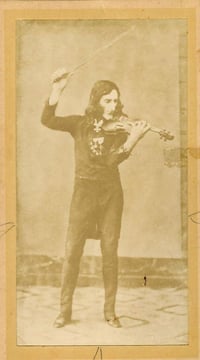
Niccolò Paganini is well-known to anyone who has even thought about picking up a violin. Yet how well do you really know this composer and violin maestro? Paganini was a towering figure who lived an extraordinary life – whose catalogue of intriguing details can't fully be recounted here. We can, however, get that list started. Here are eight fascinating secrets about Paganini.
- Paganini became an "emancipated minor" (to use modern language) when he was 14 years old. His father contributed to Paganini's early success by being a stern task master. No doubt he was a bit too stern, refusing young Paganini food to eat if he didn't practice well enough. Due to Paganini's childhood success as a public performer and composer, he became financially independent quite young and was able to separate himself legally from his father.
- Not just a composer and violinist, Paganini was also a guitarist. In fact, his musical roots were as a mandolin player (like his father). He left public life for three years, starting in 1801. It's believed he spent that time at the home of a Tuscan noblewoman who preferred he play guitar. Even after this time, Paganini was known to play guitar for private audiences, but not publicly. Many of his compositions combined guitar with other string instruments, such as the violin-guitar duet Lucca Sonatas.
- Paganini was one of the first musicians to perform without sheet music. When he was touring in the early 19th century, it was still the convention of the day for performers have their sheet music with them on stage. Paganini rejected this approach. While the creator and maestro of violin technique, he was also an extraordinary showman. He would prowl across the stage with swagger as he played, something he couldn’t do if he'd been tied down to a music stand.
- A gambler, Paganini lost his Amati violin in a bet. He was then lent a Guarnieri by an amateur violinist. Paganini would then only play a Guarnieri, most famously the one he named "Cannon." The Cannon is now on display at the Palazzo Tursi Museum, in his hometown of Genoa, Italy.
- While he was a gambler, and died in financial straits despite having become rich from his touring, Paganini was also supportive of artists who didn't achieve his financial success. He was reported to have performed for charitable institutions and at concerts to support indigent artists towards the end of his career.
- Did Paganini suffer from a variety of ailments that made it possible for him to play the violin as he did? Rumors abound. It's believed he may have had one or two genetic disorders. First is Marfan Syndrome, a disorder that affects the body's connective tissue, and which often manifests through extremely long limbs and fingers. There's also speculation that Paganini had another genetic disorder called Ehlers-Danlos, which manifests as hyper-mobility of the joints. Paganini developed techniques no one else could perform and his playing was extraordinary. It’s no wonder rumors started that would explain his unparalleled skills.
- Theory number two explaining his virtuosity was that he (or his mother) had made a pact with the devil. Due to his inexplicable dexterity and talent, and his tall, thin, gaunt appearance, he was given the nickname "Der Hexensohn," or "The Witch's Son." He was also called the "Son of the Devil." These nicknames were often taken literally. So much so that when he died, the church refused to have him buried on sacred ground. He was originally buried on family land. His body is now buried at Cimitero della Villetta in Parma. Such rumors die hard and even become modernized. Like Paganini, Robert Johnson, the innovator of new guitar technique and musical virtuoso, is also rumored to have sold his soul to the devil.
- The famous, only known image of Paganini, is not in fact Paganini! A daguerreotype was publicized in 1900, which was said to be Paganini.
Luthier Giuseppe Fiorini was the source of the image. It was eventually determined that
Fiorini is also the man in the image. Fiorini forged the image, which fooled people for decades. As Paganini died in 1840 and the dageurrotype process was barely in its infancy, having been first used in 1839, people eventually began to ask questions.

Courtesy of wikimedia: 1900 Imperial Cabinet card of famous Fiorini fake daguerreotype (photograph) of Paganini.
Paganini isn't the only great composer and musician with secrets. You can also read about the secret life of Vivaldi and amazing facts about Mozart. It seems genius is never simple.
Above image of Niccolò Paganini (1819), by Jean-Auguste-Dominique Ingres, courtesy of Wikicommons.


